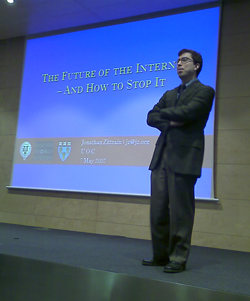The Congress on Internet, Law and Politics has the aim of continuing the task of reflecting on, analyzing and discussing the main changes taking place in law and politics in the information society. This third congress focuses on the questions that currently represent the most important challenges and new developments in the fields of copyright, data protection, Internet security, problems of responsibility, electronic voting, and the new regulation of e-Administration, as well as dedicating a specific area to the current state of the use of new technologies by law professionals.
Presentation to the Congress: Jordi Bosch, the Catalan Regional Government’s Secretary-General for Telecommunications and the Information Society
One of the biggest struggles in History has been literacy. Now that that it seemed [at least in developing countries] that we had achieved some “good” literacy level, then comes the Internet and everyone has to get into digital literacy. Indeed, last year [2006] more transistors were produced than rice grains.
Data ownership goes back to the citizen. Data is not a Government property, but citizens’. the big challenge to e-Administration is not putting online all procedures, but making them disappear. An event (i.e. your husband’s death) should automatically activate all kind of procedures (i.e. widow subsidies) without the need of having to apply for them.
Universal access should cover telephony (both fixed and mobile lines), broadband, audiovisual services and content. This access means information, training and, actually, more democratic exercise, transparency, etc.
Keynote speech: The Future of Internet and How To Stop It
Jonathan Zittrain, Professor of Internet Governance and Regulation, Oxford Internet Institute

Jonathan Zittrain
One model of computer: in the hands of experts, you rent a solution, that comes from designing software and putting it into hardware, but you never ever approach neither the machine nor the design of the solution. This is IBM’s model when it was created back in the times of Herman Hollerith when he calculated the US 1890 census. IBM (then the Tabulating Machine Company) had “general purpose” machines that could be reprogrammed for whatever.
Flexowritter represented a second model: one solution, unchangeable, nonreprogrammable, but you could have it home.
Bill Gates made up a general purpose personal computer: it could be reprogrammed by the end user, that had the machine at home.
And the story with Networks is alike. Prodigy and Compuserve would show the user closed content depending on what he wanted (i.e. Weather) and who he was (i.e. Professional).
The birth of the Internet, the network its founders built, was totally open: it had an “hourglass” architecture where any use, any platform, were joined by a common “bypass”: IP, that just moved bits from one place to another.
And collaboration goes on an on. More and more software is built upon a “procrastination principle”: we build it until here and someone will go further
. But this kind of collaboration can also be subverted to break others’ barriers to secure their content, etc.
And now the problem is that you can not malicious code, malware, viruses, etc. from operating or entering your own system without being disconnected from the Network… or go out of the generative PC paradigm where everyone could program/contribute with his own code/content. If we are going back to the “main menu”, where all options are predetermined, is this the end of the generative Internet? actually, is this the end of the Internet itself? And same applies to who connects to what . It looks like our needs to “save” our systems, are creating more and more barriers similar to those of censorship (something dealt with at the OpenNet Initiative).
Stop BadWare is about writing a software that should help knowing how some other software works and whether it is making “happier” your computer (and its user).
The generative pattern:
- Origins in a backwater
- Ambitious but not fully planned: procrastination principle
- Contribution welcomed from all corners
- Success beyond expectation
- Influx of usage
- Success is cut short: movement towards enclosure
The solution? For the solution to be true to the generative pattern, it must be originated in a backwater. The Internet is an educative system: it does require to people to give feedback and build along with the others.
See also:
3rd Internet, Law and Politics Congress (2007)
If you need to cite this article in a formal way (i.e. for bibliographical purposes) I dare suggest:
Peña-López, I. (2007) “3rd IDP Congress on Internet, Law and Politics. Briefings, part I: Jonathan Zittrain keynote speech” In ICTlogy,
#44, May 2007. Barcelona: ICTlogy.
Retrieved month dd, yyyy from
https://ictlogy.net/review/?p=538
Previous post: The 2007 e-readiness rankings: comments and critiques
 RSS feed for comments on this post.
TrackBack URI
RSS feed for comments on this post.
TrackBack URI

